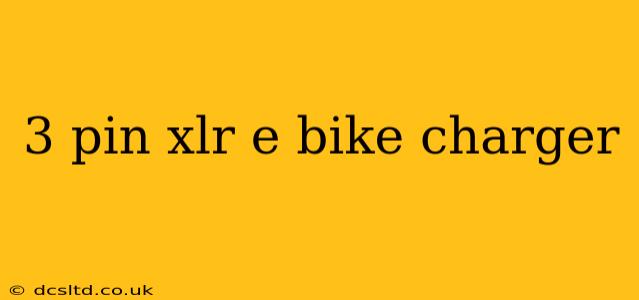Decoding the 3-Pin XLR E-Bike Charger: A Comprehensive Guide
Finding the right charger for your e-bike is crucial for its performance and longevity. If you're dealing with a 3-pin XLR e-bike charger, understanding its specifications and functionality is key. This guide delves into the specifics of this type of charger, addressing common questions and providing helpful information for e-bike owners.
What is a 3-Pin XLR Connector?
The XLR connector is a robust, circular connector commonly used in professional audio and lighting equipment. Its application in e-bike charging signifies a higher power capacity compared to smaller connectors. The "3-pin" refers to the three pins within the connector, each carrying a specific function – typically two for power (positive and negative) and one for ground. This configuration ensures efficient and safe power transfer to your e-bike's battery.
Why is a 3-Pin XLR Connector Used in E-Bikes?
The choice of a 3-pin XLR connector for e-bike chargers is often driven by the need for higher power delivery. E-bikes with larger battery capacities or those designed for high-performance applications may require faster charging times. The robust nature of the XLR connector is well-suited to handle the higher amperage required for such charging needs.
How Does a 3-Pin XLR E-Bike Charger Work?
A 3-pin XLR e-bike charger works similarly to other chargers, but with a higher capacity and current flow. It converts AC power from your wall outlet into DC power suitable for charging the e-bike's battery. The three pins ensure a secure connection, minimizing voltage drop and maximizing efficiency. The charger typically incorporates safety features like over-current protection and temperature monitoring to prevent damage to the battery and the charger itself.
What are the Different Types of 3-Pin XLR E-Bike Chargers?
While the connector type remains consistent, the charging characteristics can vary depending on the e-bike model and battery specifications. Chargers differ in:
- Voltage: This determines the power output of the charger and must match the e-bike's battery voltage. Common voltages include 48V, 36V, and 24V. Using an incorrect voltage charger can seriously damage your battery.
- Amperage (Charging Current): This dictates the speed of the charging process. Higher amperage means faster charging, but it also increases the risk of overheating if not properly managed.
- Charging Time: This varies depending on the battery capacity and the charger's amperage. Higher amperage chargers generally reduce charging time.
How to Choose the Right 3-Pin XLR E-Bike Charger?
Selecting the correct charger is paramount. Always consult your e-bike's user manual to determine the correct voltage and amperage requirements. Using an incompatible charger could lead to battery damage, fire hazards, or even void your warranty. It's also wise to consider the charging time—faster chargers are convenient but may cost more.
Is it Safe to Use a 3-Pin XLR E-Bike Charger?
When used correctly and with the appropriate safety precautions, a 3-pin XLR e-bike charger is safe. Always use the charger provided by the manufacturer or a reputable replacement. Avoid using damaged chargers or cables. Ensure the charging environment is well-ventilated to prevent overheating.
Troubleshooting Common Issues with 3-Pin XLR E-Bike Chargers
- Charger Doesn't Turn On: Check the power outlet, the charger's power cord, and the connection to the e-bike.
- Slow Charging: Ensure the battery's connection to the charger is secure. A faulty battery or charger might be the cause.
- Overheating: Check for proper ventilation and ensure you're using the correct charger.
By understanding the nuances of 3-pin XLR e-bike chargers, you can ensure the safety and longevity of your e-bike and its battery. Remember to always consult your e-bike's manual for specific instructions and recommendations.
